12 Top Ear Piercing Types & Your Guide To Each One
12 Top Ear Piercing Types & Your Guide To Each One
Have your eyes pierced on the ear party trend? Stacked earrings allow you to amplify your personal style – both on Zoom or in real life as we slowly re-emerge into the world during 2021. The layered jewelry look is nothing new and can be customized to suit a more minimalist or maximalist approach. Yet, even with its growing popularity, multiple ear piercings maintain their cutting-edge appeal. Like tattoos, piercings offer an experimental way to advance your accessorizing game – without worry about the permanence of ink.
There are numerous ear piercing placements available and they range in popularity, healing time, costs to upkeep and jewelry versatility. Before deciding on your next placement, discover the top ear piercing options to consider and your guide on everything to know about each one.

Credit: Fresh Trends/Pinterest
Standard Lobe Piercing
The standard lobe placement is most individuals’ first piercing. These piercings arguably rate the lowest on the pain scale compared to other common placements. Because there is no cartilage on the earlobe, these piercings will heal fairly quickly – within approximately six to eight weeks after your session. This lobe piercing is incredibly versatile and is simple to maintain.
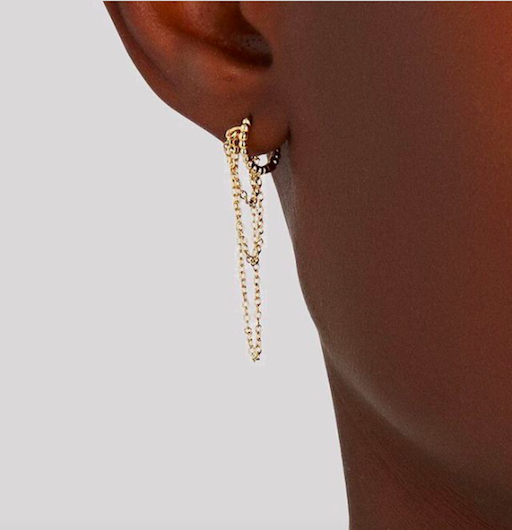
Credit: @shashinyc/Instagram
Upper Lobe Piercing
An upper lobe piercing serves as a stylish addition to your standard lobe placement. Like the standard lobe, upper lobe holes should rank relatively low on the pain scale and have a short healing time of approximately six to ten weeks. The healing process should be similar to that of your standard lobe. However, the general rule is that the higher up an ear piercing is, the longer before it heals.
Upper lobe piercings are a common second placement choice and allow you to achieve an embellished double lobe look. You can get an additional third lobe piercing, too, to expand your styling options.
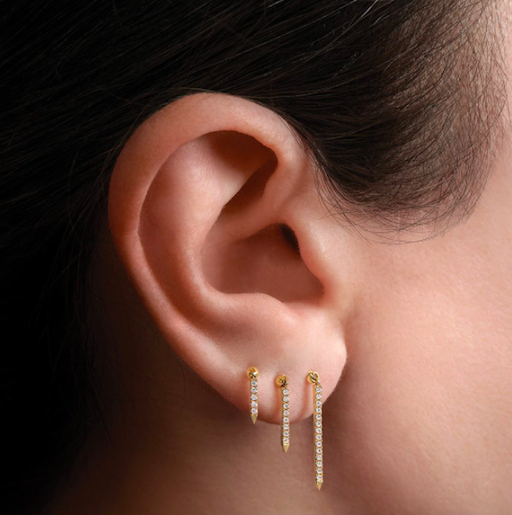
Credit: @mariatash/Instagram
Helix Piercing
Otherwise known as a cartilage piercing, a standard helix placement sits on the upper side of your outer ear. A helix placement generally refers to any piercing in this outer upper region. A double or triple helix (two to three holes in this area) offer a concentrated and layered look.
Helix piercings typically hurt more than a lobe piercing but are relatively moderate compared to other non-lobe placements. A helix piercing takes approximately three to six months to fully heal. During this time, you should avoid changing the earring and refrain from sleeping on the side of the piercing to avoid any irritation or infection.
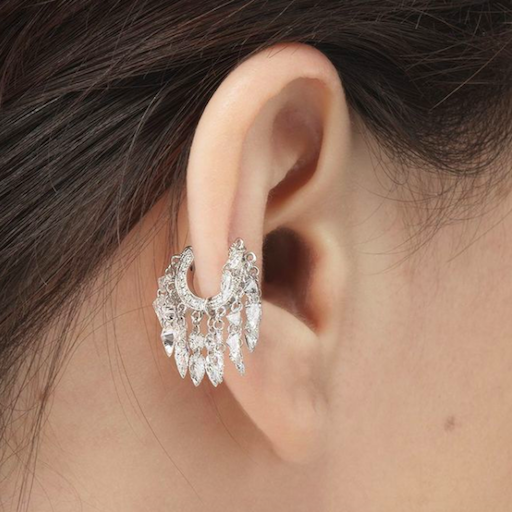
Credit: @mariatash/Instagram
Forward Helix Piercing
This placement refers to the piercing(s) on the outer cartilage area that is front-facing and located right above the tragus. With these helix piercings, you’re able to get more than a single hole done during your session –allowing you to try out a double or triple front helix placement.
Like a standard helix piercing, forward helix placements likely will feel moderate to high on the pain scale – depending on your personal tolerance. They take approximately three to nine months to heal.
These placements are often dressed up with stud earrings for an effortlessly cool and practical look.
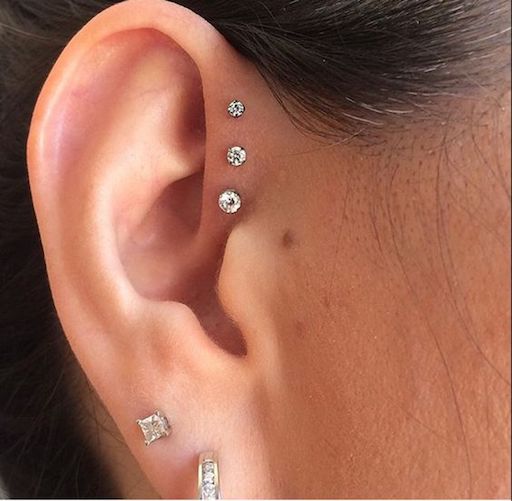
Credit: Saint Sabrina's/Pinterest
Flat Piercing
A flat piercing is located on the inner cartilage on the top of your ear, in between a helix and rook placement. Like all of the cartilage piercings mentioned above, flat piercings have a similar healing timeline and rating on the pain scale. Factors, such as your piercer’s procedure, unique pain tolerance and aftercare habits, play a role in your subjective experience.
While they are gaining popularity, flat piercings are still one of the more unconventional cartilage placements and provide an unexpected edgy look to your curated ear.
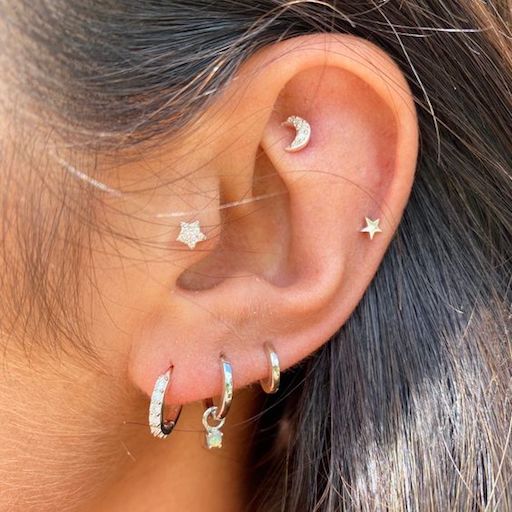
Credit: Zohreh V. Jewellery/Pinterest
Daith Piercing
Placed right above your ear canal, daith piercings are located on the small cartilage flap on your inner ear. Aside from their stylish appearance, they are commonly thought to provide relief for those who suffer from regular migraines. Currently, all evidence of these claims is anecdotal and scientists are still awaiting studies to confirm these findings. For centuries, acupuncturists have regarded the daith area as a vital pressure point and could help to support these personal success stories. Regardless, this piercing adds a cool, contemporary look to your ear party.
Daith placements are considered to be moderate to high on the pain scale. However, this pain typically has a different sensation from a helix piercing and offers a duller rather than sharp sensation during the procedure. Daith piercings tend to heal within three to nine months.
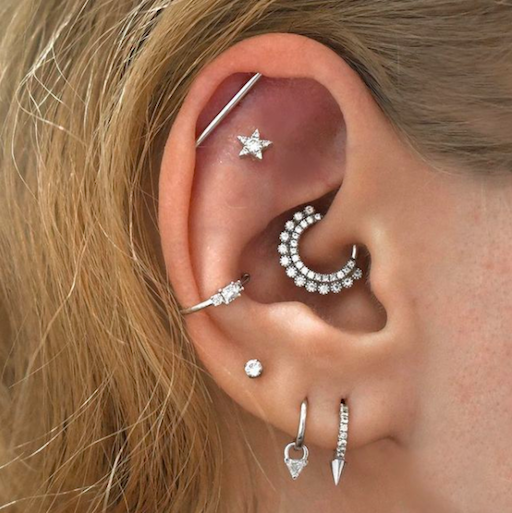
Credit: @mariatash/Instagram
Conch Piercing
Located in the middle of your cartilage, this piercing gives you placement options and several styling possibilities. Your piercer will advise whether an inner or outer conch piercing is most suitable for your ear shape. This evaluation typically comes down to the folds of your ear. Both conch piercings also cater to different jewelry options and might inform your preferred placement.
Inner conch piercings are created in the middle of the ear and are suitable for studs. Outer conch piercings are placed towards the outer portion of the area and are designed to be worn with hoop earrings or jewelry in similar styles.
Pain levels should be in line with those of other cartilage piercings, such as a daith or helix placement, and require six to nine months to heal.
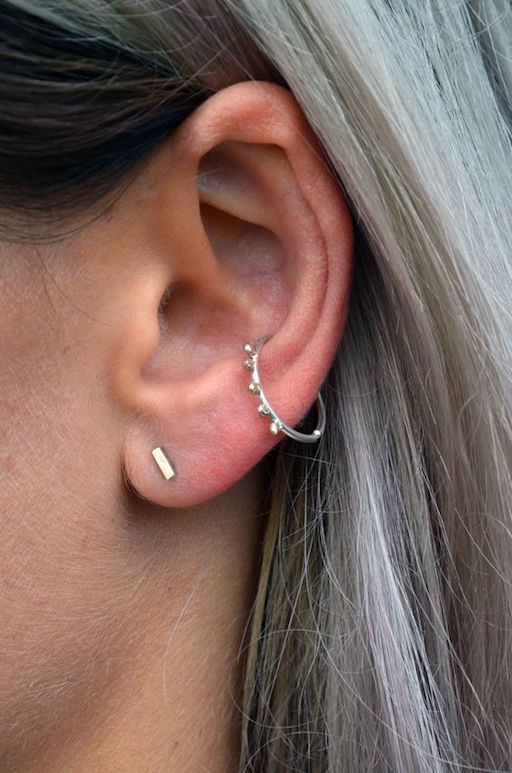
Credit: Ethical Market/Pinterest
Tragus Piercing
This cartilage piercing is placed on the small flap that partially covers your ear canal. With its cutting-edge look, tragus piercings are less risky and painful than they appear. However, it is essential to know that this piercing should always be done with a needle – never with a gun.
As a cartilage piercing, the tragus is known to be one of the least painful, swaying towards moderate on the pain scale. This placement requires at least three months to heal with a typical six to twelve-month recovery window. To allow this piercing to heal properly, it is best to avoid wearing earphones and earpods, or sleeping on your side during the healing process. While it may be difficult, these habits leave the area more susceptible to irritation or infection.

Credit: @mariatash/Instagram
Anti-Tragus Piercing
Placed right above the ear lobe, an anti-tragus piercing goes through this small curve of the ear. This placement is adjacent to the tragus, inspiring its name. For jewelry, these piercings require either a barbell or ring earring.
The anti-tragus is considered relatively high on the pain scale and should be kept in mind – especially if it is your first cartilage piercing . The healing process is similar to that of your tragus piercing: 3 months to heal and a recovery window of between six to twelve months. To protect the area, it is best to avoid wearing earphones or similar tech accessories and refrain from sleeping on the side of your piercing or twisting the jewelry.
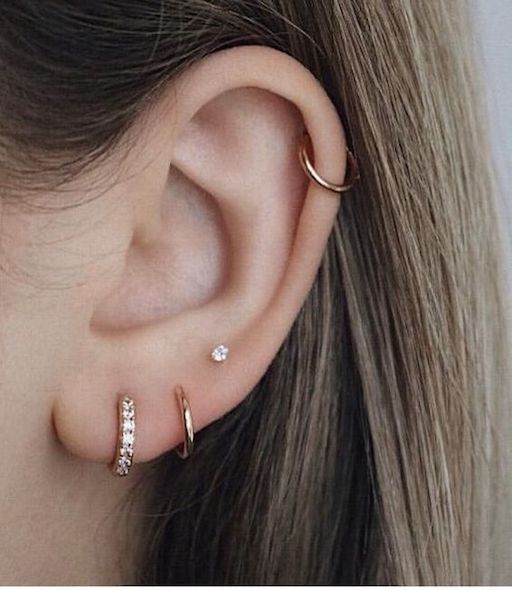
Credit: Etsy/Pinterest
Snug Piercing
Often referred to as an anti-helix, snug piercings are located on the cartilage between the inner conch and the outer rim of your ear. While this placement is known to elevate the look of any curated ear, a snug piercing is not for everyone. Some ear shapes cannot support this piercing. Before booking an appointment, schedule a consultation with an expert piercer to discuss your options.
A snug piercing is also considered one of the most painful cartilage piercings and could be the most painful overall ear piercing for some individuals. The healing process should take around four to six months, but it likely will take up to a year for the area to fully recover. Be mindful that snug piercings are highly susceptible to post-procedure trauma, so it is vital to stay diligent with your aftercare routine after the initial healing period.

Credit: @mariatash/Instagram
Rook Piercing
This placement is located on the ridge between the inner and outer parts of the upper ear. While less common than other inner earring placements, rook piercings add intrigue to an already stacked ear and are gaining popularity among those with several piercings.
Like a snug, these cartilage piercings may not be suitable for certain ear shapes and are relatively high on the pain scale. Rook piercings take approximately six to twelve months to fully heal.

Credit: @mariatash/Instagram
Industrial Piercing
Industrial piercings are any two holes connected by a barbell. However, this placement typically refers to a double piercing connected horizontally across the upper ear. It most commonly consists of holes in the helix and forward helix. Another variation is the vertical industrial placement, which includes a helix and rook or conch piercing. These piercings should always be done with a needle – never a gun.
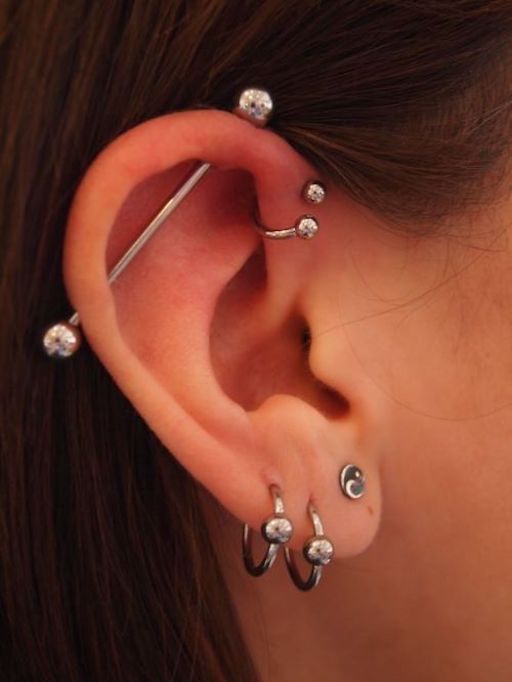
Credit: Etsy/Pinterest
On the pain scale, industrial piercings are rated fairly high. Like other cartilage piercings, the healing process usually takes approximately six to twelve months.
Ear Piercing Quick Facts & Aftercare
Each piercing typically costs between $30 and $85 with lobe piercings on the lower end and more complex placements, such as a snug or industrial piercing, on the pricier side. Check with your piercing studio to see whether the initial jewelry is covered within the cost of the session
Universally, proper aftercare is key for maintaining healthy skin and ear holes.
With price and style preferences aside, your individual pain tolerance is a factor to consider when deciding which piercings to pursue. If you’re nervous about the pain, ask your piercer whether a numbing cream can be used for your session. Zensa Numbing Cream contains 5% lidocaine to minimize pain without any vasoconstrictors, making it a safe option to use before piercing procedures. This product should provide a numbing effect on skin for 2-3 hours after application and is a vegan, steroid-free formula.
Most experts recommend cleaning the area with a saline solution twice a day during the healing process. Always wash your hands before handling the new piercing. Make sure to listen and follow your piercer’s advice precisely to prevent any infections or unnecessary mishaps during recovery.
Which ear piercing are you looking to try out next?
